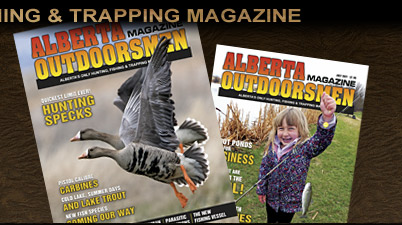|
 |
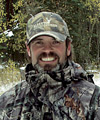 |
It was hot, way too hot to be crawling across the prairie on my hands, knees and elbows but that was exactly what I was doing. Sweat was running down my back in the extreme heat and I could feel my t-shirt sticking to me under my camo jacket. The salty stuff was running down my brow as well, stinging my eyes when the odd drop would find the right path through the dust that was always present. But the big buck was in my sights and I wasn't about to give up.
My hunting partner, Ken Colwill and I had spotted the buck four days earlier from nearly two-miles away. Our Swarovski ATS 80 spotting scope, even from that distance, picked up the buck against a backdrop of arid prairie rangeland. We knew instantly that the buck was indeed a monster and I'd been chasing him ever since, passing up other opportunities during that time frame. I had stalked to within 185-yards of a nice buck the night before and had taken a long look at him. He was a good one but I just couldn't pull the trigger knowing that the big guy was still out there and that a chance at him might still exist. Ken had already filled his tag on a great buck the second day of our hunt. But now, here I was on what I figured may very well be my last chance at the impressive antelope. I had only the morning hunt left and I was hoping seven-years of waiting wasn't going out the window.
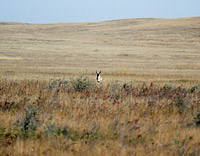 |
| An all-to-familiar sight—eagle eyes always on the lookout for danger. |
The big guy was sporting 21 does, meaning I had 44 eagle-like eyeballs scanning the prairie for any signs of trouble. The stalk was getting tougher by the moment as I was getting closer. I needed to make up another 150-yards and I would be in that 250 to 300-yard range where I could take a shot. I had practiced extensively at 300-yards and was confident in my abilities. I just needed to get there without searching eyeballs picking up my movement. But now I had a problem; I couldn't account for all 21 does, only 16 were visible with the big buck, five were missing. A patch of willow stood to the left of the herd and another to the right, the herd was in the middle and favouring the right side. Slowly I inched forward constantly looking to the left patch of willow hoping the missing does weren't there but farther to the right. If they were left my odds were slim, if they were right, I would have a great opportunity to close my tag on the big antelope. My stalk now consisted of small forward movements and a strained-neck look to the left willows. "Damn," I cursed to myself. "Where are those does?"
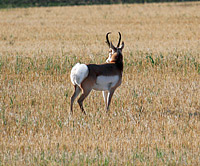 |
| From zero to 60 mph in seconds flat. |
And then suddenly all hell broke loose. A single doe stepped forward from the left willows looking right at me. A quick warning call and like a single-line hovercraft train, 22 antelope were doing 60 mph away from me in an instant. I watched with a broken heart as the big buck disappeared over the horizon with his does in tow. A two-hour stalk just went to waste.
Standing up in the blaze heat I searched for my water bottle and cursed once again, remembering what Rick Martin, Wildlife Manager of the Eastern Irrigation District had said to me five-days prior.
"Oh you shouldn't have much of a problem killing a 14-inch buck," Rick had said. "If you want something bigger though, you're going to have to work a little harder for it."
Little did I know at the time but that statement would be the understatement of the year, at least for me.
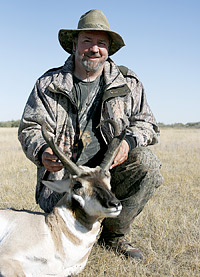 |
| Ken's EID buck. A beauty pushing better than 15-inches. |
At the time we were enjoying a wonderful mule deer roast with all the fixings, including some fried bread that Rick's wife Donna had served piping hot on a plate before us. The stuff was to die for. Donna knew how to prepare a meal and Ken and I were enjoying ourselves immensely. The food was superb and our hosts were equally as excellent.
We had waited a long time to get drawn to hunt Alberta's speed goat and had spent the first two days prior to the season opener scouting the area we planned to hunt—the Eastern Irrigation District (EID)—an area comprised of 1.5 million acres of which 600,000 acres of native prairie rangeland is privately owned by the EID, and home to a healthy population of pronghorn antelope as well as deer, moose and a surprising number of elk. In fact the elk woke us almost nightly as we slept in the canvas tent we called home for seven days.
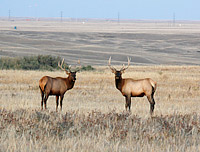 |
| The EID hosts a variety of wildlife. |
In the early 1900s the EID irrigation system was built to provide water to this part of Alberta. Here the land is very much desert-like and without water agricultural production would be almost non-existent. The EID currently supplies water to irrigate more than 281,000 acres of privately owned farmland and because of this the diversity of wildlife that lives within this region is extraordinary. From coyotes to ungulates and a large variety of bird life, it is an oasis for hunters and photographers.
The next morning, the last of my hunt, I rolled out of my cot in the dark and was soon headed back in the direction of the big buck's turf. I was going to give it one more try. A heavy fog had rolled in making visibility poor. I welcomed it though, knowing it would give me an opportunity to get to where I wanted to be undetected. And I was correct. Soon I was on the edge of the willows that had contained the hidden doe the day before. Now I just needed the fog to lift so I could see what was before me.
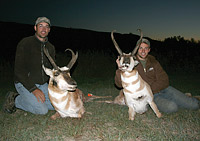 |
| Two more excellent EID bucks taken during the author's hunt. |
Slowly the fog began to lift, and then suddenly, I began to make out the shapes of antelope some 800-yards distant. Completely surprised, I realized it was my buck and his does. This time though, I was at a complete disadvantage; they were on a high point and any movement by me would be easily picked out. But I had to try. As slowly as I could, I began my stalk using the undulating terrain as best I could. Nearing 500-yards from my quarry, I knew the gig was up. They all had me pegged. It was as if the big buck was mocking me. And then, in their speed-train, hovercraft manner, they disappeared.
I stood up disappointed once again and resigned myself to the fact that my tag would go unused. And then suddenly, to my right, I caught the flash of tell-tale white and watched an antelope disappear in a recession some 300-yards away. Shocked, I resumed my stalk position and headed towards what I hoped was a good buck.
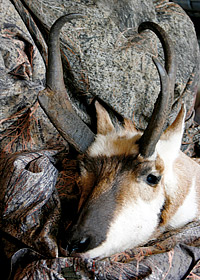 |
| The EID buck the author settled on the last morning of his hunt. |
In the end I managed to catch up to a decent antelope that must have been staying near the big buck's herd in hopes of catching an unattended doe. I closed the deal on the buck at 150-yards.
The Eastern Irrigation District is privately owned land and because of this there are rules that have to be followed, including the asking for permission on other privately owned lands that fall within the EID's property. Motorized vehicles must stay on established roads or on designated routes where such signs are posted. There are no exceptions to these rules and ATVs and motorbikes are prohibited. Maps of EID land can be obtained simply by calling their office in Brooks.
The EID is an outdoorsman's paradise with a wide range of activities allowed, but in order to maintain the privilege to access these privately owned lands in the future, users must follow public access guidelines. Please do so and this amazing part of southern Alberta will forever be open to public access. ■
Antelope Advice
When hunting antelope there are a couple of items that are a must. First, a good spotting scope. A spotting scope will give you the advantage of stability while giving you the opportunity to study your buck's horns from a great distance. This allows you to make the decision as to whether a stalk is worth the effort or not. In hot prairie weather, a wasted stalk results in wasted time and an exhausted hunter. A good spotting scope eliminates this problem. The second item is a rangefinder. Antelope are very deceiving on the open prairie. A rangefinder will guarantee you know exactly how far away your trophy buck is. After an exhausting stalk, a wasted shot because of mistaken distance will only bring disappointment.
For previous Outdoor Pursuits click here.
|
|
|
|


